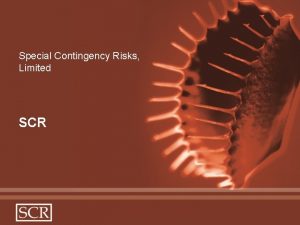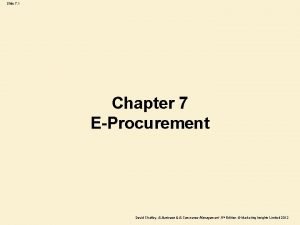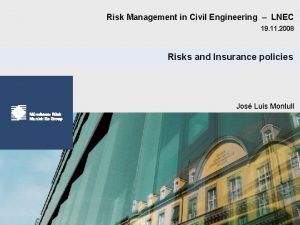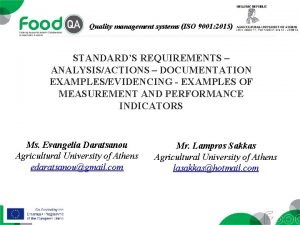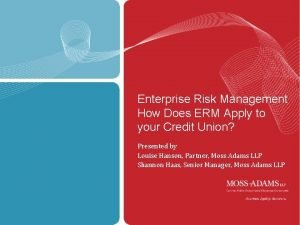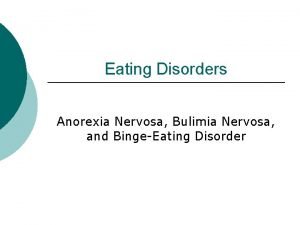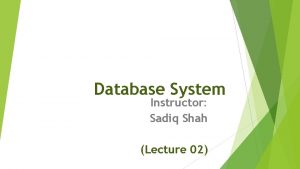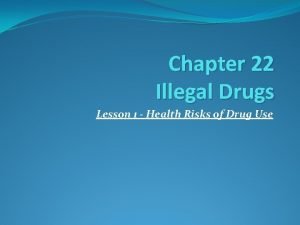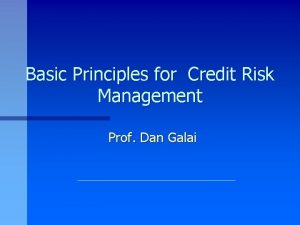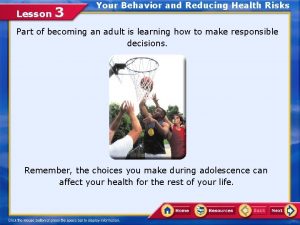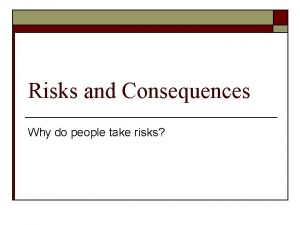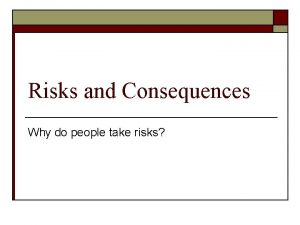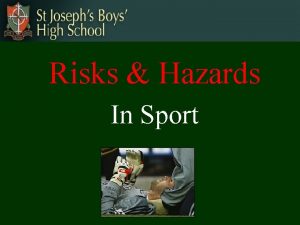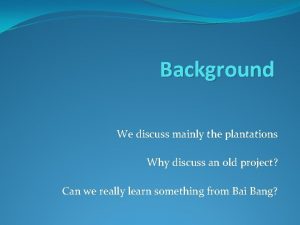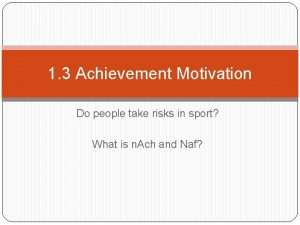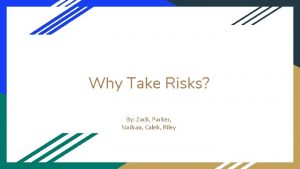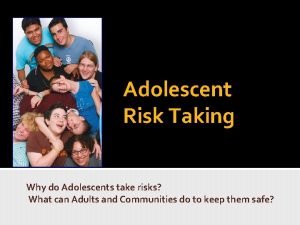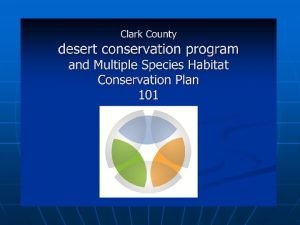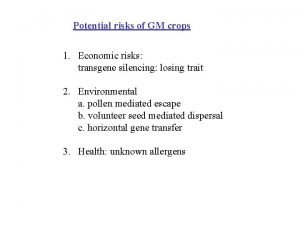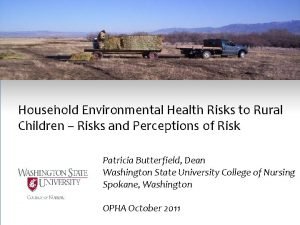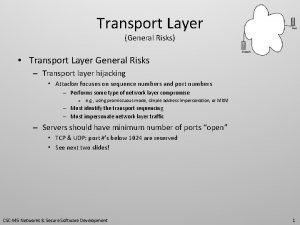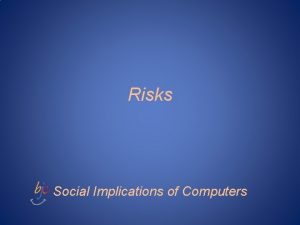Unit 07 Why do people take risks DISCUSS





















![B. THINK ABOUT BOTH R 1 and R 2. [short writing] 1. Do you B. THINK ABOUT BOTH R 1 and R 2. [short writing] 1. Do you](https://slidetodoc.com/presentation_image/3d8ccd33604da39a13c05c188e64b848/image-22.jpg)






- Slides: 28

Unit 07 Why do people take risks? • DISCUSS THESE QUESTIONS “TASK A RISK” • ARE YOU A RISK-TAKER? IF SO WHAT KIND OF RISKS?

What Do you Think? 1. Think of an activity that you perceive to be risky. Why do think it is risky? Give specific reasons. 2. Look back at the photos of the jobs on page 134. According to the latest statistics, the most dangerous job pictured is a fisherman. Did you rate fishing as a dangerous job? Why or why not? 3. Why do you think we perceive activities such as mountain climbing to be risker than they actually are?

The top dangerous jobs • Facing a serious risks on the job • Including risk of shock, explosion decompression sickness, water on their dental fillings • High risk of death

The top dangerous jobs • Fatalities due to hypothermia • Being thrown overboard & drowning • Suffering from serious injuries due to heavy machinery and gear

The top dangerous jobs • High work related fatalities • 30 times more likely to die • Major death causes are from equipment errors • Tree falling on workers

The top dangerous jobs • Hazardous chemicals including arsenic • Long term effects to health such as miscarriages birth defects, cancer, respiratory illness.

The top dangerous jobs • More risks in their career for less pay than pilots • High rate of aviation accidents (esp. Alaska)

The top dangerous jobs • Significant injury including concussions, broken bones, fractures • Not worthy of cash pay out

The top dangerous jobs • Risk of fall from great height • Risk of serious injury from steel beams • Walls collapsing on workers • High fatality rate of death

The top dangerous jobs • Most oil riggers have 16 hrs shifts • Lack of sleep • Fires & Oil rig explosion

The top dangerous jobs • Risk of being arrested • Threat of STDS, Rape, Physical assault

The top dangerous jobs • Low rate of people who have not been bitten

Reading 1. Fear Factor: Success and Risk in Extreme Sports • Mental • Pursuit • Tolerance • Notable • Challenge • Vivid • Perceive • Precaution • Aspect • Trait

Fear factor: Success & Risk in Extreme Sports • Takes place for a week in July in Spain. • It leaves lots of injuries and dangers.

Reading Skill Using referents to understand contrast In reading I, the writer is focusing on what makes one group of people different from everyone else. The writer uses certain words and phrases to refer to each group throughout the reading. Group 1 Group 2 • People who enjoy extreme sports • Some people • Others • Certain people • They • These types of people • People who don’t’ enjoy extreme sports • The rest of us • Most of us • Many people • We

A. Read the sentences from Reading 1. Underline words that refer to people who enjoy extreme sports. Circle words that refer to the majority of people. 1. Some people to embrace extreme risks, the rest of us 2. most of us, others 3. many people, others 4. certain people, others 5. these types of people, others He notes that most of us reach a point That limits our appetite for extreme risk… Referent: people who don’t enjoy extreme sports Both others have a much higher tolerance for risk. Referent: people who enjoy extreme sports

MAIN IDEAS _____ 1. Some people may have a stronger desire than others for risks because of the adrenaline flow that they get. _____ 2. Certain people may perceive risk differently from the rest of us. _____ 3. People who enjoy the risks of extreme sports also enjoy the fear. _____ 4. Not everyone has the same tolerance for risk; some of us have a much higher tolerance.

Details 1. Every year in Pamplona, Spain, hundreds of people run alongside bulls. 2. Lester Keller says that not everyone has the __________ to excel in dangerous pursuits. 3. Al Read remembers getting into situations where he thought that at any moment he ___________. 4. Shane Murphy worked with a group climbing Mount Everest __________________. 5. Statistically, mountain climbing is not as risky as __________________.

Reading 2. The Climb of My Life • • • Vocabulary Bravely Conquer Determined Distinctive Earn Goal Role Significant ultimate

WHAT DO YOU THINK? (p. 146) 1. Paragraph 1, Kelly talks about “Challenges”-climbing mountains and being sick-and says, ‘Of the two, of course, I’d rather the mountain be my physical challenge than physical challenges be my ‘mountain. ’ What does this mean for Kelly? 2. Kelly Perkins climbed mountains before and after heart transplant. Do you think the reasons for climbing mountains were different before and after her transplant? Why or why not? https: //www. growingbolder. com/kelly-perkins-211415/

“The Climb of My Life: Scaling Mountains With A Borrowed Heart. ” When Kelly Perkins was _____old, she noticed even at rest her heart would beat like crazy. It turns out she had a _____that irreparably damaged her heart. Only a donor would save her life. She said it was agonizing coming to terms with the fact that someone would have to die for her to live. But a heart did become available. Kelly vowed that not only would she make good use of the incredible gift of life she’d received, she and her ________decided to make a statement. She climbed to the top of Mount Whitney, Mount Fuji and Mount Kilimanjaro to raise awareness about the incredible need for________. She says that for the first time ever, the number of people waiting on a donor has hit 100, 000. Kelly’s experiences spurred her to write the book, “The Climb of My Life: Scaling Mountains With A Borrowed Heart. ” http: //www. craigandkelly. com/
![B THINK ABOUT BOTH R 1 and R 2 short writing 1 Do you B. THINK ABOUT BOTH R 1 and R 2. [short writing] 1. Do you](https://slidetodoc.com/presentation_image/3d8ccd33604da39a13c05c188e64b848/image-22.jpg)
B. THINK ABOUT BOTH R 1 and R 2. [short writing] 1. Do you think that people who do extreme sports would not be happy if they didn’t continue to take risks? In other words, do you think they need to take risks? 2. Do you think people can change the way they perceive risk? Are there certain situations or times in people’s lives when we perceive activities as being more or less risky?

Vocabulary skill: Dictionary Use A. Look up the underlined words in your dictionary and write the correct definition based on the context. Finding the correct meaning - Words have more than one meaning. - Different meanings are usually numbered. - Consider the context in the entire sentence. 1. that drives some people to embrace extreme risks, drive: _________________ embrace: _______________ 2. appetite for extreme risk…. . appetite: ________________ 3. same ingredient that keeps other coming back for more ingredient: _______________

Reading 2. 4. I had been cast in the role of patient. role: ___________________________________ 5. I wanted bruises to be earned from sports-related activities, not from needle pricks and aspirin-thinned blood. _ earned: _________________________________ 6. It was smooth on the back, resembling the perfectly bell-shaped dome, the front being chiseled, replicating its famous broken granite face. Face: ___________________________________

Writing Skill Writing a narrative essay • describes a personal experience and • includes three important parts: an introductory, body, and concluding statement. 출처: https: //www. google. co. kr/search? q=essay+format&newwindow=1&biw=1600&bih=758&source=lnms&tbm=isch&sa =X&ved=0 CAYQ_AUo. AWo. VCh. MI 6 e. Cjr 8 Hoxg. IVIeam. Ch 1 T 6 w. CA#imgrc=dpeys 5 n 3 RUc. Zl. M%3 A

Grammar Writers use one time frame for the entire passage, but often they shift/ change time frames. Writers often use the simple past to begin a story, or set the scene. Writers use the past perfect to describe things that happened before the events in the story. Use had + past participle to form the past perfect. Writers use the simple present to describe things or give certain facts or information.

Write a narrative essay A. Think of some risks that you’ve taken.

When? Where? Taking a risk Why did you take it? What kind of ? Dangerous ?
 Andreas carlsson bye bye bye
Andreas carlsson bye bye bye Picture composition
Picture composition Amateurs talk strategy professionals talk logistics
Amateurs talk strategy professionals talk logistics Take a bus or take a train
Take a bus or take a train What were they doing in the photograph
What were they doing in the photograph Don't ask why why why
Don't ask why why why Answer the questions in pairs
Answer the questions in pairs How many people does it take to make a pencil
How many people does it take to make a pencil People who own, operate, and take risk of a business
People who own, operate, and take risk of a business Unit 6 review questions
Unit 6 review questions A legend of the northland phoebe cary
A legend of the northland phoebe cary The biggest risk is not taking any risks
The biggest risk is not taking any risks Scr limited
Scr limited Risks of e procurement
Risks of e procurement Risks of e procurement
Risks of e procurement Risks of instant messaging in the workplace
Risks of instant messaging in the workplace Civil engineering completed risks
Civil engineering completed risks Actions to address risks and opportunities
Actions to address risks and opportunities Crl mērījums
Crl mērījums What is basel 3
What is basel 3 Risks of bulimia
Risks of bulimia Costs and risks of database approach
Costs and risks of database approach Sourcing process cips
Sourcing process cips Tracing vs vouching
Tracing vs vouching Chapter 22 lesson 1 the health risks of drug use
Chapter 22 lesson 1 the health risks of drug use A thick, sticky, dark fluid produced when tobacco burns.
A thick, sticky, dark fluid produced when tobacco burns. Principles of credit risk management
Principles of credit risk management Chapter 1 lesson 3 health risks and your behavior
Chapter 1 lesson 3 health risks and your behavior Cloud computing benefits and risks
Cloud computing benefits and risks












